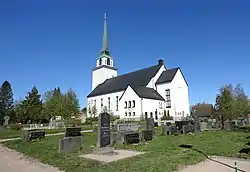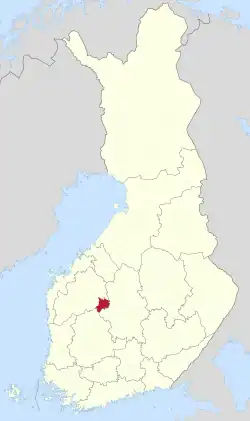Ähtäri
Ähtäri (Swedish: Etseri) is a town and municipality of Finland. It is located in the South Ostrobothnia region. The town has a population of 5,321 (26 October 2023)[2] and covers an area of 910.87 square kilometres (351.69 sq mi) of which 105 km2 (41 sq mi) is water.[1] The population density is 6.61 inhabitants per square kilometre (17.1/sq mi). Ähtäri is located 83 kilometres (52 mi) southeast of Seinäjoki.
Ähtäri
Etseri | |
|---|---|
Town | |
| Ähtärin kaupunki Etseri stad | |
 Ähäri Church was designed by architect Bertel Liljequist, and built in 1937. | |
 Coat of arms | |
 Location of Ähtäri in Finland | |
| Coordinates: 62°33′N 024°04′E | |
| Country | |
| Region | Southern Ostrobothnia |
| Sub-region | Kuusiokunnat sub-region |
| Charter | 1867 |
| Town privileges | 1986 |
| Government | |
| • Town manager | Jarmo Pienimäki |
| Area (2018-01-01)[1] | |
| • Total | 910.87 km2 (351.69 sq mi) |
| • Land | 804.96 km2 (310.80 sq mi) |
| • Water | 105 km2 (41 sq mi) |
| • Rank | 97th largest in Finland |
| Population (2023-10-26)[2] | |
| • Total | 5,321 |
| • Rank | 161st largest in Finland |
| • Density | 6.61/km2 (17.1/sq mi) |
| Population by native language | |
| • Finnish | 98.3% (official) |
| • Swedish | 0.1% |
| • Others | 1.6% |
| Population by age | |
| • 0 to 14 | 13.4% |
| • 15 to 64 | 52.9% |
| • 65 or older | 33.7% |
| Time zone | UTC+02:00 (EET) |
| • Summer (DST) | UTC+03:00 (EEST) |
| Website | www |
The municipality is unilingual Finnish.
Ähtäri is known for its zoo and hotel Mesikämmen designed by Timo and Tuomo Suomalainen which is partly built within bedrock. The biggest lake in the area is Ähtärinjärvi. There is also a relatively old and small board mill called Vääräkosken Pahvi in Ähtäri.
The largest private sector employers are Inhan Tehtaat, Silver-Veneet, Tankki, and Muovilami.
Notable people
- Anton Collin, cross country skier and road cyclist
- Eero Hiironen, sculptor and painter
- Kari Hirvonen, lead singer of Tango King
- Aki Hintsa, sports physician and orthopedic surgeon
- Toivo Korpela, preacher and speaker; fervent Laestadian and founder of the Korpela movement
- Niko Korsumäki, Snowcrossing World Championship bronze medalist
- Esa Latva-Äijö, actor
- Veikko Mattila, Member of Parliament
- Matti Pekkanen, engineer and politician
- Emanuel Pohjaväre, Member of Parliament
- Mikko Savola, Member of Parliament
- Topi Sorsakoski, musician
- Antti Tammilehto, musician
- Seppo Tammilehto, musician
- Edvard Valpas-Hänninen, former chairman of the Social Democratic Party of Finland
Notable groups
- Noumena, melodic death metal band
See also
References
- "Area of Finnish Municipalities 1.1.2018" (PDF). National Land Survey of Finland. Retrieved 30 January 2018.
- "Preliminary population statistics 2023, September". StatFin. Statistics Finland. Retrieved 26 October 2023.
- "Demographic Structure by area as of 31 December 2022". Statistics Finland's PX-Web databases. Statistics Finland. Retrieved 6 September 2023.
- "Population according to age (1-year) and sex by area and the regional division of each statistical reference year, 2003–2020". StatFin. Statistics Finland. Retrieved 2 May 2021.
External links
 Media related to Ähtäri at Wikimedia Commons
Media related to Ähtäri at Wikimedia Commons- Municipality of Ähtäri – Official website
